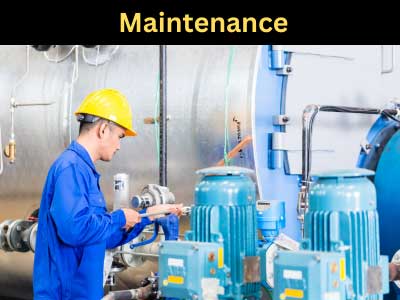Key Takeaway
There are several types of maintenance, each serving a unique purpose:
Preventive Maintenance: Regular, scheduled tasks to prevent equipment failures.
Predictive Maintenance: Uses data analysis to predict equipment failures before they occur.
Corrective Maintenance: Performed after equipment has failed, focusing on repairs.
Condition-Based Maintenance: Monitors the actual condition of equipment to decide when maintenance is needed.
Total Productive Maintenance (TPM): Involves all employees in maintaining equipment to improve overall effectiveness.
Each type of maintenance plays a crucial role in ensuring equipment operates efficiently and reliably, minimizing downtime and maximizing productivity.
Predictive Maintenance
Predictive maintenance (PdM) is a data-driven approach that utilizes sensors, machine learning algorithms, and analytics to predict when equipment failures might occur. Unlike preventive maintenance, which is performed on a set schedule, predictive maintenance uses real-time data to monitor the condition of machines. This information helps maintenance teams anticipate problems before they happen, reducing unplanned downtime and ensuring that maintenance is performed only when necessary.
In industries where equipment failure can lead to significant production losses, predictive maintenance offers a cost-effective solution. Sensors monitor variables like temperature, pressure, and vibration to detect early warning signs of mechanical wear. Once a potential issue is identified, maintenance can be scheduled at a convenient time to avoid production stoppages. While predictive maintenance requires a higher initial investment in technology and training, the long-term savings from reduced downtime and optimized maintenance schedules make it an attractive option for many industries.

Preventive Maintenance
Preventive maintenance is a proactive strategy designed to reduce the likelihood of equipment failure by performing regular maintenance tasks on a predetermined schedule. It involves inspecting, servicing, and replacing parts based on usage or time intervals, regardless of the machine’s current condition. Common tasks include lubrication, cleaning, minor repairs, and part replacement.
While preventive maintenance reduces the risk of unexpected breakdowns, it can sometimes lead to unnecessary maintenance if the machine is still in good working condition. Nonetheless, this approach is particularly beneficial for critical equipment where failures would result in costly downtime. Preventive maintenance ensures that machinery is consistently maintained, which prolongs its lifespan and reduces the need for major repairs. The main challenge with this approach is finding the right balance between under-maintaining and over-maintaining assets.
In industries where the cost of downtime is high, a preventive maintenance schedule ensures that operations remain smooth. By following regular intervals, businesses can avoid major disruptions while keeping repair costs manageable.
Reactive Maintenance
Reactive maintenance, often referred to as “run-to-failure,” is a strategy where repairs are only performed after equipment breaks down. This approach is typically used when machinery is not critical to daily operations, and the cost of failure is relatively low. While it might seem cost-effective in the short term, reactive maintenance can lead to significant issues over time, including unplanned downtime, increased repair costs, and shorter equipment lifespans.
One of the main drawbacks of reactive maintenance is the unpredictability of failures. When equipment breaks down unexpectedly, it can disrupt production schedules, cause safety hazards, and require emergency repairs, which are often more expensive than scheduled maintenance. Despite these disadvantages, reactive maintenance can be suitable for non-essential equipment or systems with low failure consequences. It is important to weigh the risks and costs when deciding whether to rely on reactive maintenance.
Industries with limited operational downtime can afford to take a reactive approach, but this type of maintenance should be used sparingly to avoid potential losses in productivity.
Condition-Based Maintenance
Condition-based maintenance (CBM) is a strategy that monitors the actual condition of machinery to determine when maintenance should be performed. Rather than performing maintenance on a fixed schedule, CBM uses real-time data from sensors and diagnostic tools to assess equipment health. Maintenance is only carried out when there are signs of deterioration or performance issues.
CBM can help reduce unnecessary maintenance tasks, extend the life of components, and lower the overall cost of repairs. However, implementing condition-based maintenance requires investment in sensors and monitoring systems to gather the data needed for accurate assessments. This approach is particularly effective for high-value equipment or systems that require continuous operation. For example, in industries like aerospace or energy, where downtime and equipment failure are extremely costly, CBM can prevent breakdowns while minimizing maintenance expenses.
By focusing on the actual state of machinery, businesses can avoid over-maintaining equipment and ensure that repairs are made only when needed. This optimizes resource use and reduces the risk of unexpected failures.
Reliability-Centered Maintenance (RCM)
Reliability-centered maintenance (RCM) is a systematic approach that focuses on preserving system functionality and optimizing the reliability of equipment. Unlike traditional maintenance strategies, RCM takes into account the criticality of each piece of equipment to determine the best maintenance strategy. It is a comprehensive approach that integrates predictive, preventive, and reactive maintenance, depending on the equipment’s importance to the operation.
The process of RCM starts with analyzing the potential failure modes of equipment and determining how these failures could impact operations. Maintenance strategies are then developed based on the failure’s potential impact, with the goal of minimizing the likelihood of failure while maintaining system performance. RCM is especially useful in industries such as aviation, oil and gas, and manufacturing, where equipment reliability is crucial for safety and production continuity.
Implementing RCM can lead to increased equipment availability, reduced maintenance costs, and improved safety. However, it requires thorough analysis and continuous monitoring to ensure that the maintenance strategy remains aligned with operational needs.
Conclusion
Selecting the appropriate maintenance strategy is essential for balancing cost, reliability, and operational efficiency. Predictive maintenance offers data-driven insights to prevent failures, while preventive maintenance ensures regular care and maintenance of equipment. Reactive maintenance might be suitable for non-critical systems, whereas condition-based and reliability-centered maintenance provide more tailored approaches to optimizing performance and extending equipment life.
By understanding the strengths and limitations of each maintenance type, businesses can develop a maintenance plan that minimizes downtime, extends equipment lifespan, and reduces overall operational costs.
